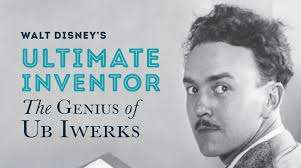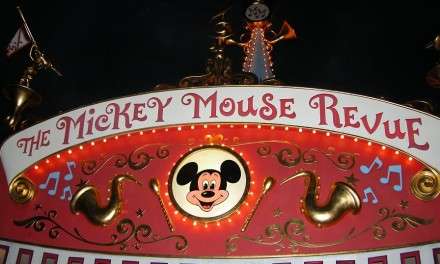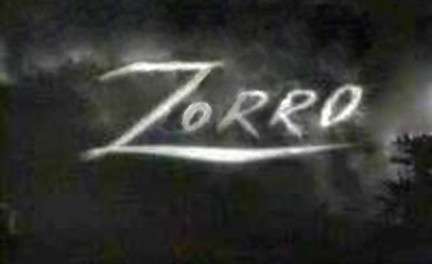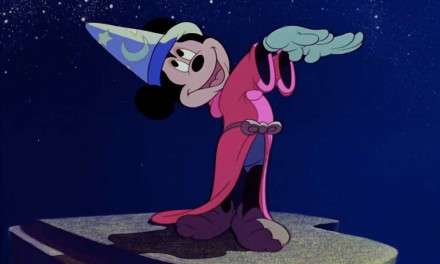It is not often that a writer has the opportunity to report on a ground-breaking story, but for this writer, that dream has come to fruition. I was contacted by Don’s PR representative to review perhaps one of the most important books on Disney history written and to interview Don. I have loved Disney and its history since childhood, and have been blessed with writing about and covering Disney press events for 15 years.
So much Disney history is being lost to the sands of time. Sadly, as the years go by, another person intimately involved with the Company is gone, and so many who have personally worked with Walt have passed. Although voluminous writings exist about Walt and his company, what is being lost is the unwritten, undocumented conversations and meetings between Walt and his many artisans, animators, directors and the like.
This interview is with Don Iwerks, the son of Ub Iwerks, who is responsible for enabling Walt’s dreams to turn into reality. Ub is the man who drew Mickey Mouse when the fledging Disney Brothers Studios lost Oswald to Paramount and Charles Mintz. He personally animated the first three Mickey shorts cartoons. He also gave rise to the famous “Silly Symphonies” cartoon series with his brilliant animation of the skeletons in “The Skeleton Dance”, the series first entry. Ub left the studio in 1930 due to personal conflicts, but returned to the fold in 1940, and was given full control by Walt to work his magic of innovations and techniques, and he produced dozens of processes, special effects and devices and methods still in use today. Today his son Don proudly introduces his book to the world, telling his father’ story and how his genius, creativity and innovative ideas improved the film industry and to introduce Ub Iwerks to a new legion of Disney fans. I firmly believe that without the genius of Ub Iwerks and Walt Disney combined, the Disney Company today would have a far different look…
WI- Where and when were you born?…
DI- I was born in 1929 in Los Angeles, Saint Vincent’s Hospital.
WI- As a child, did your dad talk a lot about working with Walt and himself?…
DI- No, no, we didn’t really discuss Walt until I was probably almost ready to go to work there. I certainly knew about him. My dad grew up on the basis he was very serious about his work, my mother would take care of the kids, we never got involved with his work and he never discussed it.
WI- Growing up, did you enjoy Disney cartoons and comics?
DI- Yeah, I enjoyed his cartoons, for sure.
WI- Did your dad ever discuss with you how he had a part in creating these cartoons?
DI- No, I just watched them.
WI- What kind of hobbies do you have? Your dad had many, bowling, archery, and he loved sailing…
DI- I do. Metalworking, woodworking, landscape painting, sculpture, computers, mechanical design.
WI- Was your dad an influence in your hobby choices, did he encourage them?
DI- Oh yes, he did. He helped launch me in a sense. Photography was one of the very early ones. He bought me a 35mm camera when I was showing interest, taught me how to load cassettes with a black and white film, how to develop and print my own photos. He had a darkroom; he built a darkroom in the garage. He also had a shop that had metalworking tools and woodworking tools. I gravitated towards that, and once I showed interest in that, he showed an interest in helping me learn…
WI- So your dad was a huge influence on you in your career at Disney and your love of mechanics?…
DI- Yes.
WI- What would you consider your most cherished memories of your dad?…
DI- Oh, I think that problem-solving was fun because he actually treated me more like an equal than as a kid. Many times, we would spend a lunch hour, or other company time, discussing the solutions to certain mechanical problems, that was really fun.
WI- When did your interest peak in mechanics, as a youth or gradually as you got older?…
DI- Throughout all my life. I respected him, I cherished the time we spent together when I was younger learning how to use his tools, but particularly after I went to work at the studio, and was assigned to work with him on getting a lot of his projects built in the machine shop; I would say it began when I was in Jr. High and throughout the rest of his and my career.
WI- Were you a natural like your father in innovation and mechanics? your dad did not have any formal education…
DI- Yeah, I didn’t go to college either. I went from High School into working in a machine shop, drafted into the service, actually before I went into the service, I worked for about 8 or 9 months at the studio in the processing laboratory. I came back from the army, went back to the lab for a short time, but I had contracted a skin problem while in the service when my hands contacted photo developer, so I couldn’t stay there, so I moved to the machine shop because I had experience and stayed there the rest of my career.
WI- You have made, like your father’s amazing contributions to the film industry, cameras, technical systems, and innovations. Do you credit your dad for helping you become the inventor that you are?…
DI- My dad was, but I never considered myself anywhere near equal to him. I worked in the shop with a lot of other people, who were mechanical engineers, who put on paper the invention he wanted to create. I was in the shop as a foreman and could see that his work was built and put into operation.
WI- Do you believe your father held a little resentment against Walt for not giving him credit for much of his work?
DI- No, none whatsoever. Some people would ask if he was upset because Walt got all the credit for Mickey Mouse. His answer was “It isn’t the creation of the character that counts, its what you do with it after you created it” He gave Walt full credit for making something out of Mickey Mouse.
WI- Did your father ever talk about how he and Walt worked together?…
DI- No, not at all. He was very private about all of that. His concentration was on his job and his work. He wasn’t one to discuss that with anybody. He was a very private person.
WI- Was your dad a workaholic like Walt? Did he like to take time to relax and wind down?…
DI- No, he would take time to relax. He loved bowling, archery, he loved the hobby of gunsmithing. He collected old muzzle-loading rifles, he made many of his own parts, cast his own lead bullets, but he was not one to hunt, shoot animals or birds. His view was that he excelled and strived to be good and accurate. When he bowled a 300 game, when he did that, well that’s all there is to that game, he put his ball in the closet and that was that. When it came to shooting, going up to the range, it was getting a bull’s eye, how close he could get a pattern into the bull’s eye. The same with archery.
WI- I want to ask about your daughter Leslie, famous in her own right as a director, producer, and writer. How much of an influence were you in her career choices?…
DI- She was artistic as a youngster, loved to draw, loved cartoons and when it came time to go to college, she went to USC to study film. She was the director of the documentary “The Hand Behind the Mouse: The Ub Iwerks Story”
WI- Did you give her assistance in the documentary, offer much help?…
DI- As much as she would ask for. I did not intrude upon her if I take any credit for anything it was introducing her to Roy Disney, Walt’s grandson. He was in charge of animation at the studio for many years. Anyway, I asked Roy if he would have a meeting with Leslie to discuss the making of this film, Roy got behind it and got the studio to finance it. That is the only role I played in it was the introduction. Once Roy was talking to her, they worked together.
WI- When did you decide to write this book about all your dad’s contributions and inventions?…
DI- It was 2007, I was working with Diane Disney, Walt’s Daughter. She was building a Museum in San Francisco. I was working for her in a sense to restore some equipment, to start with, it was the multi-plane camera. There were three of them, one at the studio in the archives, the other in Euro-Disney and the third one in pieces. I convinced her to ask to accept it as a gift, on loan or however she could get it, and we could restore the third multi-plane stand. It was during that time working with her, I wrote her a little booklet describing other artifacts that I recommended she ask for from the studio for display at the Museum.
She mentions to me that I didn’t know all this information, it’s wonderful. You could make this into a book. I got to thinking, I really should get started, the world really does not know in any detail about all of the significant inventions that helped Walt make a success of his company. In 2007 I began, worked on it off and on, not fulltime. Around 2014, I had enough so I should start looking for someone to publish it. My good friend Marty Skylar, president of Walt Disney Imagineering, had written several books and Disney published them and I talked to him about how I could get started with this. First, you have to get someone to represent you. So, I did, he recommended his agent who was in New York, I signed with him to push my manuscript for publication. The first choice was to have Disney publish it. He was successful to have Disney take it on.
WI- The book contains many photos and illustrations I never saw before.
DI- A lot of those photos are my personal photos, and I used the Disney photo library for Disney photographs. Most of the illustrations, in fact, all of the illustrations in the book are my own drawings of what the device looked like if I didn’t have a photograph of it. I am a believer in a picture is worth a thousand words, trying to explain things that are technical without being overly technical. The challenge was printing a book to get wide readership and that was Disney’s Edition’s concern too.
WI- In my personal opinion, without your father and his innovations and having animated first hand the Alice Comedies, Oswald the Lucky Rabbit series and the first three Mickey Mouse cartoon shorts, Disney would be a different Company today. Your thoughts?…
DI- I can’t speculate on something like that. I had people tell me, people, who worked at the studio tell me that three, actually four primary people; one person told me that Walt, Roy, my dad, and Gunther Lessing were the starters. My dad left in 1930 and the company still managed to go. Obviously, Mickey Mouse helped get them underway, no question. In my book, because there has been a lot written about those early years, I didn’t want to spend a lot of time going over that again. Disney Editions wanted me to have a chapter on it, so I consented to that. But my interest was giving my dad some credit for all of these other significant inventions and processes that he made in the studio, particularly when he came back.
WI- From all I have read, your dad and Walt were very different in personalities and outlooks. Yet together they formed an unbeatable team unleashing significant ideas and innovations. Your thoughts on that…
DI- I would not say they were opposites; they were both geniuses but in different ways. Walt was a storyteller; Walt had the instinct or the belief that he should surround himself with people in many cases know more about what they are doing then Walt did. When my dad came back to the studio, you could say they have been apart for ten years, is it going to work?. Ben Sharpsteen, a director at the studio was a friend of my dad and Walt. When he suggested to Walt would he be interested in my dad coming back after he closed his studio in 1940, Walt said: “Why don’t you look into it”. Ben had lunch with my dad and talked about possibly coming back. My dad never told me directly, it has been reported that basically he would be open to that if Walt was open to it. They had a meeting; it was a very congenial meeting. People have said that they thought there was animosity between them after he came back, but that couldn’t be further from the truth. I was witness to many times they were together; it was like they were old friends.
WI- What do you consider your highlight working at the Disney studios?
DI- I would have to say probably the EPCOT effort, was the best time in my personal career. It’s hard to pick anyone because there were so many things I was involved with that plain enjoyable and fun. After I became in charge of the machine shop, I had the opportunity to figure out how we were going to take on some challenges, like the projectors for Walt Disney World. Just before Walt Disney World opened, my dad passed away. But before he did, we were able to develop a new projector which I describe in the book that made it possible to run films in the park. I am very satisfied I was able to be in charge of an operation to build all of that projection equipment we put in EPCOT.
WI- Gone are many people who actually worked and spoke with Walt. Did you feel comfortable in his presence, was he easy to talk to?
DI- I didn’t personally have a lot of opportunities to talk with him because, during the 1964 World’s Fair, he was in our shop a lot, but I was one of the worker bees, even though I was a foreman. He and I were on a first-name basis as were many people with him. He didn’t like the formality of “Mr.” Walt was his name and he would call me by my name. With the amount of interchange, I have with him, it was always a pleasure; I never felt intimidated, he was a man. I could recall times when I could see him, maybe on the street, he was not dressed immaculate, he could be wearing a cardigan sweater, just dressed like anybody else. When you passed him on the street, he would call you by name, “Hi Don”, “Hi Walt”, “how’s it going?”, blah blah blah.
WI- Were you a natural draftsman like your dad, could you draw well and animate?
DI- Well, I would not say very well, but I did like drawing, both sketching and painting, and mechanical drawing. I still do the mechanical drawing but now on a computer.
WI- Didn’t your dad win an Academy Award on Alfred Hitchcock’s “The Birds”?
DI- He didn’t win an Academy Award; he won a nomination for his work on the Birds. His comment on his submission of his work for that award, he mentioned that a good special effect, you would never know you saw it!
WI- What advice would you give to any aspiring Disney “Imagineer”?
DI- Well, I don’t know. I just had the opportunity to go to work out of High School. I had planned to Art Center School because I liked photography; I’m glad in hindsight that didn’t work out, I don’t know if one can be successful in that. The opportunity to work in the studio with all the creativity was unbelievable. But to answer the question, in this day and age, it’s probably important to go to college and get a degree because a lot of places won’t hire you unless you have a degree. Back in the days when I worked for the studio, that was not necessary. It would depend on the job. Going into the lab and moving over to the machine shop, I knew how to run the machines, so I don’t know if a degree would have made any difference at all.
So now you know that three generations of Iwerks have made an enduring legacy for Walt Disney and the rest of the cinematic universe. Very soon I will have the complete review of this amazing book that should be on all Disneyphile bookshelves. I again thank Don Iwerks for his time and patience with this interview…
You can obtain this historic book from “AMAZON.COM” or contact “DISNEY EDITIONS- 978-1-4847-4337-1 and on EBOOK 978-1-368-01342-0





